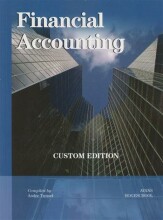Summary: Introduction To Management Accounting Global Edition | 9780273790013 | Charles T Horngren
- This + 400k other summaries
- A unique study and practice tool
- Never study anything twice again
- Get the grades you hope for
- 100% sure, 100% understanding
Read the summary and the most important questions on Introduction to Management Accounting Global Edition | 9780273790013 | Charles T. Horngren ...
-
1 Understanding Corporate Annual Reports: Basic Financial Statements
This is a preview. There are 2 more flashcards available for chapter 1
Show more cards here -
Why is accounting essential for decision makers and managers?
Because it is essential to understand the system that generates accounting information in order to use that information in any of a wide variety of functional decisions (including purchasing, manufacturing, inventory management, hiring, marketing, and pricing, among others). -
What is a budget?
A budget is aquantitative (factors that can be measured in numbers) expression of a plan of action and an aid tocoordinating andimplementing plans. Budgets are used to translate the organization's goals into action. -
What do performance reports do?
Performance reports compare actual results tobudgets. Managers use these reports to monitor, evaluate, and reward performance and, thus, exercise control. -
Which two important ideas should managers keep in mind when designing accounting systems?
(1) The cost-benefit balance and (2) behavioral implications. -
What are behavioral implications?
It is the accounting system's effect on the behavior, specifically the decisions, of managers. -
Why are ethics and standards of ethical conduct important to accountants?
Because most users of accounting information cannot directly assess the quality of that information, and if they cannot rely on accountants to produce unbiased information, the information will have little value to them. -
What is the cost-benefit balance (or cost-benefit considerations)?
It is weighing estimated costs against probable benefits, the primary consideration in choosing among accounting systems and methods. -
2 Introduction to cost behaviour and cost-volume-profit relationships
This is a preview. There are 24 more flashcards available for chapter 2
Show more cards here -
What is the cost driver?
The cost driver is the number of units produced and sold, which we assume drives all the resource costs. -
What is the decision context?
The circumstances surrounding the decision for which the cost will be used. -
What are step costs?
Costs that change abruptly at different levels of activity because the resources are available only in indivisible chunks.
- Higher grades + faster learning
- Never study anything twice
- 100% sure, 100% understanding































